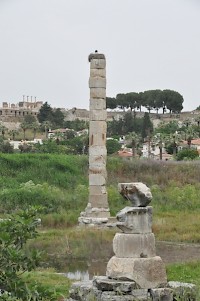Seven Wonders of the Ancient World
Seven Wonders of the Ancient World: Greek list of seven amazing works of architecture. The selection was several times adapted to cultural changes.

Making lists is one of the oldest types of science and scholarship; it well-attested in the ancient Near East and sometimes called Listenwissenschaft. If the Bible states that king Solomon had much wisdom, we may assume that he possessed long lists of things.
The ancient Greeks were no exeption. For example, they had lists of admirable epic poets (starting with Homer and Hesiod) and tragic playwrights (Aeschylus, Sophocles, Euripides). These lists became popular when, after the conquests of Alexander the Great, many Greeks settled overseas. Their position as an elite in countries like Egypt, Babylonia, and Bactria depended on their being-Greek, and canons of exemplary texts were important: unlike the native population, a real Greek had read these authors and knew how and when to quote them.
The list of Seven Wonders of the World belongs to this category of texts: splendid buildings, worthy of emulation. The original list, now lost, contained seven Greek buildings, but in the early third century, non-Greek monuments were included as well. It expressed the novel idea that the barbarians could also produce fine works of art, an idea that can be found in the books by several scholars and philosophers of the first generations after Alexander the Great (e.g., by Eratosthenes of Cyrene; text).
One of the first known lists was made by Antipater of Sidon, who lived in the first half of the second century. It survives in the collection of poetry known as the Anthologia Palatina (9.58):
- The walls of Babylon
- Phidias' statue of Zeus in Olympia
- The hanging gardens of Babylon
- The colossus of Rhodes
- The pyramids of Egypt
- The Mausoleum of Halicarnassus
- The temple of Artemis in Ephesus
Later, the first item was replaced by the Lighthouse of Alexandria, and this has become the canonical list. However, the ancient sources mention other wonders of the world, like an obelisk in Babylon and the palace of Cyrus in Ecbatana. Christian authors inserted Noah's Ark, the Temple of Salomo in Jerusalem, and the Hagia Sophia in Constantinople. Beda Venerabilis wrote a treatise on the Seven Wonders, in which he mentioned the Capitol, the Lighthouse of Alexandria, the colossus of Rhodes, a figure of Bellerophon, the theater of Heraclea, a bathhouse, and the temple of Artemis.
The joke that a particular building ought to be called the "eighth wonder" was made for the first time by Cassiodorus (sixth century), who called the entire city of Rome one wonder. However, the poet Martial (40-c.102) had already called Rome's Colosseum the world's one and only truly amazing building.
Literature
- K. Brodersen, Die Sieben Weltwunder. Legendäre Kunst- und Bauwerke der Antike (1996)